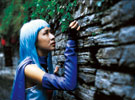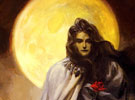性别与种族之间的关联在编制它的花名册或在阐释它的作品过程中,永远不会成为对抽象表现主义进行持久分析的主题,尽管这样的关联在其他社会领域受到关注,在这些领域里,人们已经注意到了美国的黑人所受到的日常压制与女性和男同性恋所遭遇到的日常压迫之间的类似性与差异性。(49)我是不是在暗示在抽象表现主义的边缘存在着一种男同性恋、女同性恋、女性或黑人的美学?不是的,尽管人们可以这样去讨论。但是[……]重要的是要问,是谁在1940年代讲话;要注意到他们讲话的立场和观点,要辨别和分析他们的观点和他们的作品被神话了的机构的目的。(50)同时,我并不想试图解构那些被认为是抽象表现主义的东西,或者也不想给它最重要的人物抹黑。相反,我想说明的是,如果没有注意到它在20世纪中期的抽象艺术中作为最高价值标准的时候,它显示了代表那个时代的种族主义与性别主义的排外性,那么再使用这个术语就是不适当了。这种方法(广而言之,成为后现代的特征,就是坚持知识与权力的同谋)坚持认为,抽象艺术就像写作、讲演和自然主义的艺术一样,都是其意义由它的使用所决定的符号。
扩大艺术背景(抽象表现主义存在于这个背景中)的理解,为的是包括种族与性别的潜台词,这样也就大大扩大了“主要”人物的作品的意义,或者提升了“次要”画家的作品的重要性。它显示了思考艺术史的目的与方法的一种途径,表明有多个层次——经济的、社会的,以及美学的——在这样的基础上,价值的问题才可以被决定。说抽象艺术在当时处在1950年代的纽约的艺术规则之外,但具有许多它的风格特征,那么,这意味着是在典范中打进一个楔子,这个楔子正是在种族主义和性别主义这个缝隙处打碎了这个典范。
审视或重新审视抽象表现主义与种族及性别的关系的时候,要把它放到20世纪中期美国的权力关系背景中。它并没有把战后纽约中的抽象艺术归纳为仅仅与异性恋男性白人精英有关的视觉经验,而是把它置于作为黑人与/或女性与/或女同性恋或男同性恋的文化经验的关系中。它把这些群体中的人们的作品放在抽象表现主义的丰富思想文化背景中,也放到历史压力的语境中,这些不一样的群体就是在这样的历史压力的语境中从事活动的。
注释:
(1)David Craven, ‘Abstract Expressionism and Third World Art: A Post-Colonial Approach to “American Art,”’, Oxford Art Journal 14 (1990):1.
(2)这些因素评估了这种局外人的艺术的性质,也是出于他们的成功,近年来学者们研究了这些因素。以下出版物都提了对它的批评、策展和市场成功的大量解释:Serge Guilbaut, How New York Stole the Idea of Modern Art (Chicago: University of Chicago Press, 1983); Ellen Lawrence, Nancy R.Versaci, and Judith E.Tolnick, Flying Tigers: Painting and Sculpture in New York, 1936-1946 (Providence, R.I.: Bell Gallery, Brown University, 1985); Abstract Expressionism: The Critical Developments, Michael Auping编 (New York: Harry N. Abrams, 1987); Ann Gison与Stephen Polcari联合主编:Art Journal 47 (Fall 1988)专刊‘New Myths for Old: Revising Abstract Expressionism’
(3)一直到1990年代,多数艺术史家都强调抽象表现主义画家同情生产的非主流身份与方式,看作是他们的文化探索的广度与他们的对立立场的真诚。参见Craven: ‘Abstract Expressionism and Third World Art’; W. Jackson Rushing, ‘The Impact of Nietzsche and Northwest Coast Indian Art on Barnett Newman’s Idea of Redemption in the Abstract Sublime,’ Art Journal 47 (Fall 1988): 189-192; and Stephen Polcari, ‘Adoph Gottlieb’s Allegorical Epic of World War II,’ Art Journal 47 (Fall 1988): 203. 与这种模式例外的一些近年研究包括Michael Leja, ch. 2, ‘The Mythmakers and the Primitive: Gottlieb, Newman, and Still,’ in Reframing Abstract Expressionism: Subjectivity and Painting in the 1940s (New Haven: Yale University Press, 1993), and W. Jackson Rushing, ch. 1, ‘The Idea of the Indian: Collection Native America,’ 见 Native American Art and the New York Avant-Garde (Austin: University of Texas Press, 1995).
(4)格林伯格:《前卫艺术与庸俗文化》,[Chapter 1]重印于Clement Greenberg: The Collected Essays and Criticism, ed. John O’Brian (Chicago: University of Chicago Press, 1986), 1:15.
(5)这是Jane Gallop讨论的一种观念的延伸,即人的身体可以历史地理解为是各种矛盾的概念相交汇的地方。Jane Gallop, Thinking Through the Body (New York: Columbia University Press, 1988), esp. 132.
(6)Janet Wolf在Feminine Sentences (Berkeley: University of California Press, 1990), ch.7, ‘Texts and Institution, Problems of Feminist Criticism.’中对此有所评述。还有一些例外。例如,参见Michael Baxandall, ‘Intentional Visual Interest; Picasso’s Portrait of Kahnweller,’ in Patterns of Intention《意图的模式》 (New Haven: Yale University Press, 1985),以及Lowery Stokes Sims论Wilfredo Lam的著作,如 ‘Myths and Primitivism: The Work of Lam in the Context of the New York School and the School of Paris, 1942-1952,’ in Wifredo Lam and His Contemporaries, 1938-1952 (New York: The Studio Museum in Harlem, 1992), 71-88.
(7)关于对经典性的讨论(试图把艺术描述为一种可以历史定位的活动,以对应于被看作是英雄人物的超验生产),参见Tom Gretton, ‘New Lamps for Old,’ in The New Art History (Atlantic Highlands, N.J.: Humanities Press, 1988), 68-69.
(8)Lawrence Alloway, ‘Systemic Painting’ (1996), in Topics in American Art Since 1945 (New York: W.W.Norton, 1975),77.
(9)Herbert Ferber and Robert Motherwell in ‘Artists’ Sessions at Studio 35 (1950),’ in Modern Artists in America (New York: Wittenborn Schultz, 1951),19.
(10)Willem de Kooning, ‘What Abstract Art Means to Me,’ Bulletin of the Museum of Modern Art 18 (Spring 1951); 重印于Herschel Chipp, Theories of Modern Art (Berkeley: University of California Press, 1968), 556.
(11)Mark Rothko, ‘The Romantics Were Prompted,’ Possibilites 1 (1947-48): 84.
(12)Barnett Newman, ‘The Sublime Is Now,’ in ‘The Ideas of Art: Six Opinions on What Is Sublime in Art?’ Tiger’s Eye 6 ( December 1948): 53.
(13)Mark Rothko, ‘Statement on His Attitude in Painting,’ Tiger’s Eye 9 (October 1949): 114.
(14)Ad Reinhart, ‘Artists’ Sessions at Studio 35 (1950), ’21.










